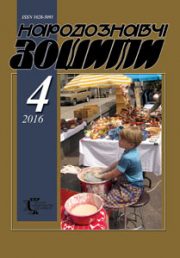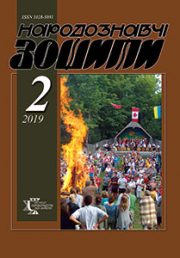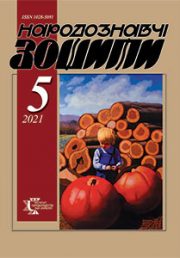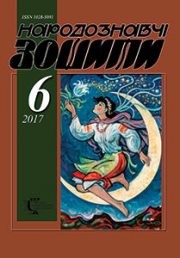The Ethnology Notebooks. 2019, № 4 (148), 867—877
УДК 572.9
DOI https://doi.org/10.15407/nz2019.04.867
HEAD-RELATED TEXT IN THE TRADITIONAL SLAVIC CULTURE (BASED ON THE MATERIAL ABOUT SPELLS)
TEMCHENKO Andriy
ORCID ID: http://orcid.org/0000-0003-3999-9459
Candidate of Historical Sciences, Associate Professor
Associate Professor of the Department of the Ukrainian History
of the Bohdan Khmelnytsky National University of Cherkasy,
81, boulevard of Shevchenko, 18000, Tcherkasy, Ukraine.
Contacts: e-mail: temchen@ukr.net
Abstract. Introduction. The «head» takes an important place in the Slavic mythology. This anatomical structure is perceived as a system of signs, which form cultural text.
Problem Statement. This text is reconstructed by representatives of various humanitarian branches; however, the issue has not been sufficiently studied in the Ukrainian ethnology.
Purpose. To reproduce the mythological meanings of the head-related text.
Methods. Understanding the text as a mega sign involves using structuralism methods, where the text appears as a system of binary oppositions.
Results. The structure of the head-related text is formed on the basis of associative comparisons of elements of the human face with the natural or landscape phenomena. The secondary simulator system is the ability to perform comprehension actions associated with qualitative characteristics of the glance, facial expressions and words. As a result on failure to meet the standards, there is a «deterioration» of the initial qualities of the glance and the word, which explains the emergence of the «evil eye».
It is established that the structure of the head-related text is formed on the binary principle, where the pair of «nose-ears» (passive perception) is opposed to the pair of «eyes-mouth» (perception + transmission of information). Besides, the «head» is a model of the vertical structure of the mythological universe: «top-eye» / «middle-nose-ears» / «bottom-mouth».
The main focus is on the mythology of the face parts — eyes, breath, mouth, and lips. In particular, the symbolism of the «eye» is combined with the situation of visibility, which in mythology acquires an ambivalent meaning, which explains the origin of beliefs that the soul is hidden in the eyes, as well as the rules of «regulation» of the glance. The «throat-breath» serves as a portal through which «enters» the Spirit, which feeds the body, and through that the last breath «goes out», which explains the beliefs about the lethal conditions. The lips and mouth is the «door» that regulates breathing in and out, silence and speaking, as well as arbitrary physiological reactions. In healing texts, the semantic gradation of the following concepts can be traced: «mouth» / sky → »mouth» / earth → »jaws» / other world.
Conclusion. The head-related text makes the branched structure of mythological meanings, built on the principle of binary oppositions, which is similar in Slavic cultures.
Keywords: mythological worldview, head as the structure, eyes / glance, feelings / ears / nose, mouth / jaws, healing ceremonies.
Received 16.05.2019
REFERENCES
Temchenko, A. (2016). Mythology of hair in the medical practices of the Slavs. The Ethnology Notebooks. 1 (127), 30—37 [in Ukrainian].
Temchenko, A. (2018). Body text: the opposition «pure / unclean» in the mythological representations of the Slavs. Philology, IV (49), 51—53. DOI: 10.31174/SEND-Ph2018166V149.
Temchenko, A. (2016). Blood in the mythological beliefs of the Eastern Slavs (a study of medical orders). Bulletin of Cherkasy University. Series: Historical Sciences, 3—4, 40—45 [in Ukrainian].
Temchenko, A. (2015). The mythology of the body in the healingmagic of the Ukrainians. Scientific notes of Volodymyr Hnatyuk Ternopil National Pedagogical University. Series: History (Issue 2, part 1, pp. 183—186).
Temchenko, A. (2015). The mouth in the mythological representations of the Slavs (a study of orders). Scientific notes of Volodymyr Hnatyuk Ternopil National Pedagogical University. Series: History (Issue 1, part 3, pp. 78—83) [in Ukrainian].
Temchenko, A. (2015). Semantics of the lower body in the mythological representations of Ukrainians. Ukraine in the ethno-cultural dimension of centuries (Issue 5, pp. 82—90) [in Ukrainian].
Temchenko, A. (2015). Semantics of corporality in medical practices of Ukrainian Polissya. Bulletin of Cherkasy University. Series «Historical Sciences», 9 [342], 43—47 [in Ukrainian].
Jung, K.G. Magical Properties of a Man’s Head and Skull (From the article «The Symbol of Transformation in the Mass»). Retrieved from: http://ec-dejavu.ru/h/Head-2.html (Last accessed: 19.04.2019) [in Russian].
Onian, R. (1999). On the knees of the gods. The origins of European thought about soul, mind, body, time, world and fate. Moscow: Progress-Tradition [in Russian].
Nepodkosov, S.V. (2014). The «dead head» symbol. Moscow: Veche [in Russian].
Vogler, N. Semiotics of everyday life: body. Retrieved from: https://syg.ma/@vogler/siemiotika-povsiednievnogho-tielo (Last accessed: 19.04.2019) [in Russian].
Benu, A. (2011). The symbolism of fairy tales and myths of the peoples of the world. Man is a myth, a fairy tale is you. Moscow: Algorithm [in Russian].
Nazarenko, Yu.A. (1995). The phenomenon of man in the Slavic traditional culture: the head. Kunstkamera: Ethnographic notebooks (Issue 8—9, pp. P. 75—97). St. Petersburg: MAE RAS [in Russian].
Melnichuk, O.S. (Ed.). (1982). The etymological dictionary of the Ukrainian language: in 7 v. (Vol. 1). Kyiv: Scientific thought [in Ukrainian].
Fasmer, M., & Larin, B.A. (Ed.). (1986). The etymological dictionary of the Russian language: in 4 v. (Vol. 1). Moscow: Progress [in Russian].
Sirotkin, V. (2003). The head of a person in legal-and-ceremonial symbolism. Body in the texts of cultures. Studios on cultural anthropology (Pp. 50—54). Kyiv: National Academy of Sciences of Ukraine; M.T. Rylsky Institute of Art Studies, Folklore Studies and Ethnology [in Ukrainian].
Bondarenko, G.B. (2003). Grandfather is bald, grandmother is bald. Symbols and semantics of hair in traditional representations of Ukrainians. Body in the texts of cultures. Studios on cultural anthropology (Pp. 55—62). Kyiv: National Academy of Sciences of Ukraine; M.T. Rylsky Institute of Art Studies, Folklore Studies and Ethnology [in Ukrainian].
Prigarin, O. (2003). Beard and its sign functions in the representations of the Old Believers of the Danube. Body in the texts of cultures. Studios on cultural anthropology (Pp. 63—68). Kyiv: National Academy of Sciences of Ukraine; M.T. Rylsky Institute of Art Studies, Folklore Studies and Ethnology [in Ukrainian].
Eliade, M. (1998). The myth of eternal return. Archetypes and repeatability. St. Petersburg: Ateleya [in Russian].
Eliade, M. (1959). The Sacred and the Profane the Nature of Religion. Trask: A Harvest Book Harcourt, Brace & World, Inc. New York.
Bayburin, A.K. (1983). Housing in the representations of the Eastern Slavs. Leningrad: Science [in Russian].
Mishanich, O.V. (Ed.). (1990). Chronicle of Rus. According to Hypatian list. Kyiv: Dnipro [in Ukrainian].
Temchenko, A. (2004). Representation of Ukrainians about the carnal soul (a study of orders «from lessons»). Bereginya, 1, 38—44 [in Ukrainian].
Sumtsov, N.F. (1891, August). Explanation of the Little Thoughts. Kyevskaia staryna (Vol. ХХХІV, pp. 9—11) [in Russian].
Tolstaya, S.M., & Tolstoj, N.Y. (Ed.). (1999). Soul. Slavonic antiquities: an ethnolinguistic dictionary: in 5 v. (Vol. 2, pp. 162—167). Moscow: International Relations [in Russian].
Levkiyevskaya, E.E., Plotnikova, A.A., & Tolstoj, N.Y. (Ed.). (1999) Two-souled. Slavonic antiquities: an ethnolinguistic dictionary: in 5 v. (Vol. 2, pp. 29—31). Moscow: International Relations [in Russian].
Propp, V.Ya., & Putilov, B.N. (Eds.). (1958). Bylinas: in 2 v. (Vol. 1). Moscow: Fiction [in Russian].
Talanchuk, O.M. (Ed.). (1992). Recipes of folk medicine, ordering from illness. Ukrainian charm (Pp. 32—95). Kyiv: Lybid’ [in Ukrainian].
Agapkina, T.A., Levkiyevskaya, E.E., & Toporkov, A.L. (Eds.). (2003). Polesye conspiracies (in the records of 1970—1990-ies). Moscow: Indrik [in Russian].
Chubynsky, P.P. (1995). Wisdom of the Centuries. Ukrainian folklore in Pavlo Chubynsky’s creative heritage: in 2 v. (Vol. 1).Kyiv: Art [in Ukrainian].
Kovalyova, I.F. (1989). Social and spiritual culture of the tribes of the Bronze Age (a study of the Left Bank of Ukraine). Dnipropetrovsk: Dnipropetrovsk Orders of the Labor Red Banner State University.
Fasmer, M., & Laryn, B.A. (Ed.). (1986). The etymological dictionary of the Russian language: in 4 v. (Vol. 2). Moscow: Progress [in Russian].
Egazarov, A. (Ed.). (1995). Encyclopedia of Superstitions. Moscow: Myth [in Russian].
Sumtsov, N.F. (1890, January). Cultural Experiences. Kyevskaia staryna (Vol. ХХVІІІ, pp. 60—90) [in Russian].
Shevchuk, T. (2003). How a «fig» became «an indecent gesture» (to the question of transformation of ancient religious symbols). Body in the texts of cultures. Studios on cultural anthropology (Pp. 167—170). Kyiv: National Academy of Sciences of Ukraine; M.T. Rylsky Institute of Art Studies, Folklore Studies and Ethnology [in Ukrainian].
Makovsky, M.M. (2005). The phenomenon of taboo in traditions and in the language of Indo-Europeans. Essence — forms — development. Moscow: ComBook [in Russian].
Fasmer, M., & Laryn, B.A. (Ed.). (1987). The etymological dictionary of the Russian language: in 4 v. (Vol. 3). Moscow: Progress [in Russian].
Tolstoy, N.I. (Ed.). (1995). Eyes. Slavonic antiquities: an ethnolinguistic dictionary: in 5 v. (Vol. 1, pp. 500—502). Moscow: International Relations [in Russian].
Seletsky, A. (1886). Sorcery in Southwestern Russia in the eighteenth century. How they judged and drove in the village of Zaporozhye. Edition of the Kyevan old days. Kyiv: A. Davidenko’s printing house [in Russian].
Velmezova, E.V. (2004). Chekh conspiracies. Studies and texts. Moscow: Indrik [in Russian].
Darkevich, V.P. (1960). Symbols of heavenly shining in the ornament of Ancient Rus. Soviet archaeology, 4, 56—67 [in Russian].
Propp, V.Ya. (1996). Historical roots of the fairy tale. St. Petersburg: St. Petersburg University Publishing House [in Russian].







